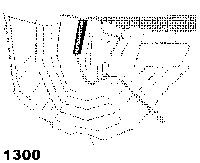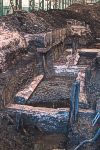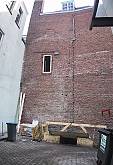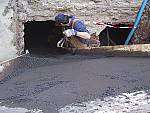|
beginning
About one thousand years ago large areas from and around the present Amsterdam were just swamp and peat and
stood largely under water, making it that from the beginning on transportation was done by boat.
The oldest and at that time not unimportant settlement (stelle in the Frankische language) with a church
and market in the region of present Amsterdam is the more southern situated Aemstelle:
nowadays known as the town Ouderkerk aan de Amstel.

The family
Heren van Aemstel
(Lords of Amstel) played from the 11th until the end of the13th
century a leading role in the development of the Amstelland (a territory owned by the Roman Catholic diocese Sticht Utrecht).
The last one of them, Jan van Amstel, has been poetized by
Joost van den Vondel
in his famous play Gijsbreght van Aemstel.

On the small delta, formed by the river Amstel (then called Ammerak, whereby aem and rak
mean in the old-Fries language respectively (river)mouth and the big water) which flows here into Het IJ, and by the
river Boerenwetering (now the Nieuwezijds Voorburgwal) which runs in the Amstel at the present Nieuwezijds Kolk,
arise in the 11th century a couple of small hamlets.
With Het IJ so close to the (in the northeast laying) turbulent Zuiderzee means each time fighting against the storm tides threatening the first hamlets.
Around the turn of the 12th to the 3th century a sort of dam is constructed where both rivers flow in Het IJ.
Halfway the 13th century a real dam is built in the mouth of Het IJ as a means to fight against the wild water, resulting in a good
loading and unloading harbour. With this so created Plaetse also called d'Ammerak is at the same time
the Heart of Amsterdam born, now known as Damplein (Damsquare).
A hamlet is developing on the spot of the present Wallen and dikes are built along the river Amstel.

In the middle of the 14th century these couple of hamlets together form the base for the first settlement of Amsterdam
and is for the first time mentioned in a writing dated 1275: in that year count Floris V of Holland grants a
toll privilege
(tax-exemption) to the 'lieden wonende te Aemstelledam'.
Notice, the word Aemstelledam does not necessary mean it has anything to do with the river Amstel, it may also be a combination
of the previous mentioned words aem, stelle and dam.

Amsterdam obtaines in 1300 of 1301 her
city rights
but a few years later she must give them back, possibly due to the city's couple of weeks of lodging in 1304 of the last
Lord Jan van Amstel, just before his definitive defeat.
In 1306 Amsterdam gets her city rights once and for all: she is allowed to run itself, independent of
Bishop, Count and Lord.
For centuries the (every time chosen for one year) council exists of four mayors and
the vroedschap (town fathers) , being an elitist group of 36 merchants. They carry out all the city tasks except the
rechtspraak (law and justice). This is done by one schout and 7 to 9 schepenen.

The city is quite young and small in comparison to other, much larger cities at that time like Haarlem, Leiden, Nijmegen,
Utrecht and Dordrecht. However, in the middle of the 15th century Amsterdam is strongly coming up, not in the last place for its
popularity among the pilgrims.

The language spoken in Amsterdam is from
origine
Frisian, but through trading and seagoing the Low German language largely takes over.
It is the immigration of all kind of cultures in the 17th century that provides the
different neighbourhood bounded accents.
Two centuries later only half of the Amsterdammers speak with Amsterdam accents.

Because of the attraction of the city her boundaries must repeatedly be enlarged, which means in the beginning
the digging of canals and erecting of city walls for military protection.
The terms Oudezijde and Nieuwezijde in streetnames are no time indicators, but refer to
the parish deviding of the Old and New Church.
The city enlargement starting in 1612 is at that time the largest in the world (the city is getting one and a half times bigger)
and, inspired by the Renaissance, an
ideal city
will be built: one is a chic residential area, laid out in a half circle, now known as the Grachtengordel (canal girdle),
being everything inside Herengracht and Prinsengracht, the other is the Jordaan, meant for the small and large industries
(like the 'lijnbanen', roperies).
The first canals are dug out for defence reasons, but they got soon more important for freight reasons.
The three canals (Heren-, Keizers- en Prinsengracht) are laid out as waterways for their new inhabitants:
merchants who became rich by oversees tradings.

For some centuries no expansions are done.
For a long time the city is in huge economical problems.
Even people are moving out to other cities in Germany and Belgium.
There is a lot of poverty and slums are formed.

At the end of the 19th century the city council decides to fill up several canals
to fulfill the wishes of the merchants with their booming horse-and-wagon traffic.
Many canals are being
filled up.
But when in 1901 the Reguliersgracht threatens to be filled, the protest of the
Amsterdam citizens is so intense that the city stops with further destroying its canals.

In the 20th century there is again a population growth and, with the demand for larger living space per person,
large scaled uniform districts are being built and after that new and independent socalled
tuinsteden (garden cities) arise around Amsterdam.

With the installing of the storm flood barriers (large lock gates, which in emergency can seal off the mouths of the Amsterdam
canals and rivers from Het IJ) and the finishing in 1932 of the
afsluitdijk
(the IJsselmeer Barrier Dam) which devides the IJsselmeer from the Wadden Sea,
the waterproblem is possibly solved for a very long time.
|
|










